The French have developed a national art of creating wonderful dishes from the best ingredients since the origins of haute cuisine in the 17th century. The love of French food, at last, overtook the English-speaking world in the 2oth century. Even the simple French word for the kitchen (cuisine) has come to mean the best food of all categories to be had in any country. Taking meals in the company of family, friends and acquaintances to enjoy conversation at the table is a national pastime. The French Gastronomic meal is even listed by Unesco as an intangible cultural heritage of humanity! At these meals, the food itself is always the most important topic discussed. Not only do the French prepare the finest food but will discuss or even argue about its details. Let’s read about Food from France.
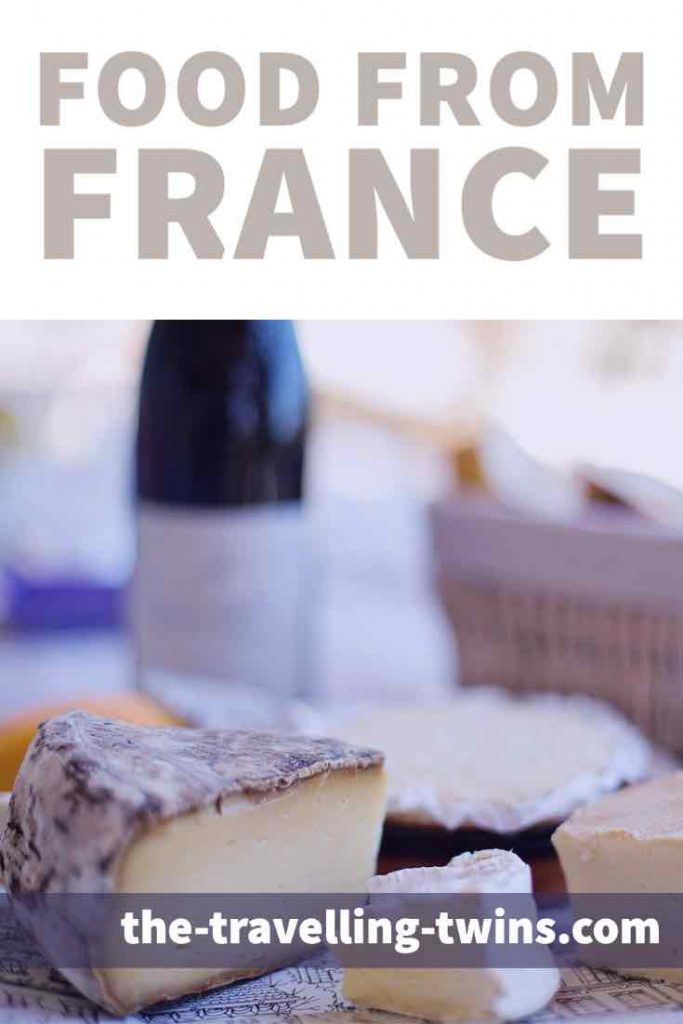
What do the French eat for Breakfast?
The classic French Breakfast consists mainly of sweet products. So fans of sweets will be delighted.
The simplest French breakfast comprises croissants and a bowl of coffee with milk (cafe au lait). Croissants are the archetypal piece of Viennoiserie – a branch of baking using yeast dough but more similar in form to a kind of ultra-light – falling to pieces – oily flaky pastry. Croissants are sweet, and they can be sweeter still with chocolate inside, (Pain au Chocolat). They should be warm with the chocolate soft and gooey inside, or eat them with jam and butter. Other sweet treats for breakfast include Petit Suisse – something like a little stiff Greek yoghurt that you turn out onto your plate, mash in sugar and spoon it into your mouth.
And then there is French bread, of course, characterised by the slim long white loaves known as baguettes or flutes. These have to be eaten ultra-fresh, and it’s a common sight to see French people carrying them home more than once a day from the local boulangerie.
Overall though, breakfast is the least important French meal of the day – better to keep space in your belly for the main event.
French foods for dinner
Onion soup
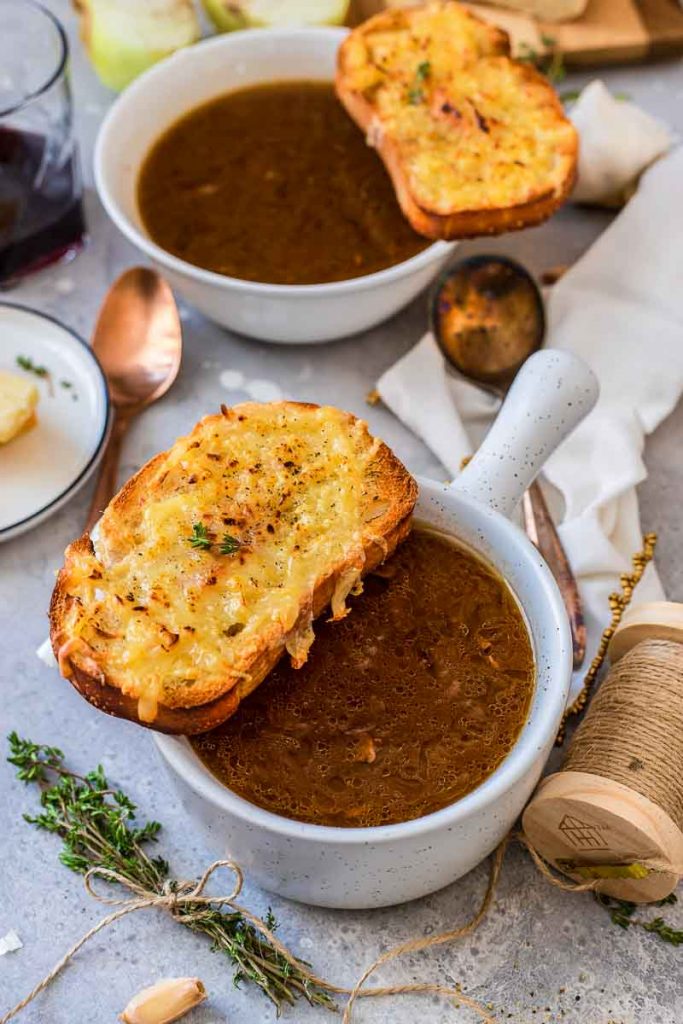
French Onion Soup (soupe à l oignon) is one of the most popular traditional French recipes. Available in almost every restaurant in France, it is prepared from a rich beef or pork broth, perhaps with white wine. But of course, the defining characteristic is the sweet flavour and texture of caramelized onions. Onion soup is usually served with toasted croutons and sprinkled with grated Gruyere cheese. What does French onion soup taste like? Although a clear soup, it has a thick solid texture, it is slightly sweet and, above all, deliciously tasty!
Coq au Vin
The technique of first frying meat, (sometimes described as “sealing in the juices” and sometimes as “bringing out the flavour” depending on the tradition or scientific bent of your correspondent) followed by stewing with liquid in an oven casserole is known either as braising or sometimes pot roasting. However, it is described; however – it is a typical French technique and nowhere is the result more delicious a representation of French food than in a perfect Coq au Vin.
As you might expect from the title, the recipe is simple here – the meat is a cock and the liquid wine. Traditionally red Burgundy is used, but variants include the use of white wine, so in Alsace, for example, you will find Coq au Riesling. The wine sauce traditionally includes mushrooms too. Of course cocks are not so commonly available nowadays as chickens, and Coq au Vin is frequently prepared with chicken. Braising however is the perfect cooking method for less tender meats because it breaks down their more fibrous nature, and so perhaps purists would insist that the real flavour and texture of the dish requires the authentic bird.
I can’t help observing that Coq au Vin is not such a different recipe from Boeuf Bourguignon, but historical sources suggest that this recipe is much older, perhaps originating in Roman France much more than a millennium before its cousin.
Bouillabaisse – seafood stew from Marseille
Bouillabaisse is another classic of French recipes designed to optimize less-expensive ingredients. Tradition has it that the Fishermen of Marseille created this unique French fish stew to use up the bony varieties of fish which they couldn’t sell in the markets. The name comes from the cooking method, which means to boil first and then to simmer.
Part of the unique quality of a Bouillabaisse comes not only from the Provencal herbs which you would expect to find in any dish originating from the Mediterannean coastal region but also the broth which is made with leeks, celery and onions as well as tomato.
Now, long after the time of its humble beginnings in France, you can expect to find a Bouillabaisse on the menu of the smartest restaurants, with more expensive lobster and crab substituted for the original rockfish with the addition of spices like saffron and orange peel.
A tradition of this stew is that the fish is removed from the broth before it is served and brought to the table in separate dishes, sometimes the soup is taken first with the seafood to follow, or they may be reassembled in the diner’s bowl. Perhaps the reason for the tradition is that the shelled or bony meat needs some care in eating, so the process is made easier if it is to be fished out of the bowl to drip onto the dress shirts and dresses of the gourmets.
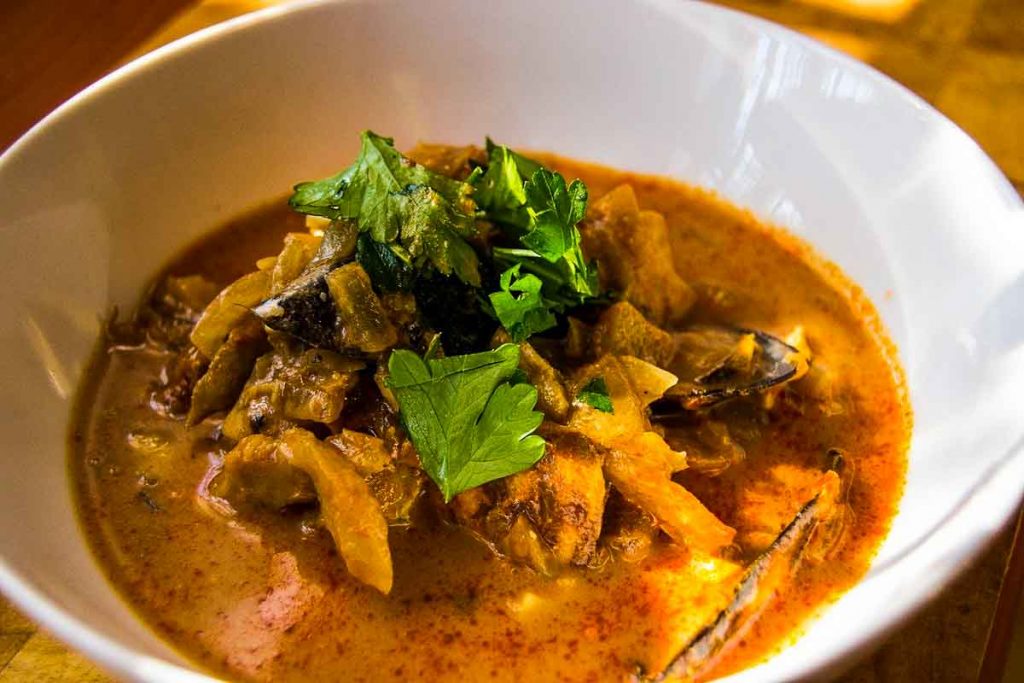
Ratatouille
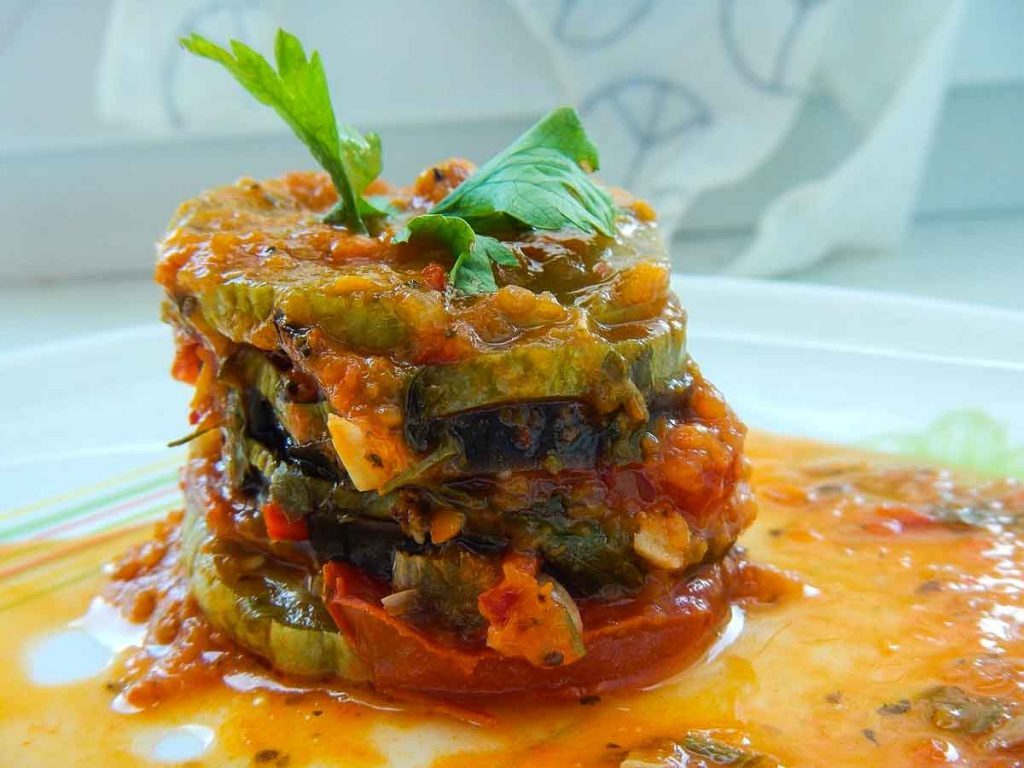
Ratatouille is a classic vegetable stew originating in Nice, France. The essential ingredients are first fried and then stewed. A Ratatouille will comprise seasonal vegetables: peppers, zucchini, aubergine, tomatoes and onions. The whole is seasoned with Provencal herbs, and sometimes also with wine. Ratatouille can be served as a main course, as an addition to meat dishes or it can be used for stuffing pancakes. Sometimes it may even be served chilled as a cold appetizer. The aromatic flavour of long-stewed and perfectly seasoned vegetables makes ratatouille appeal even to those who do not normally like vegetarian dishes.
Ratatouille become even more famous thanks to a kids movie Ratatouille
Boeuf Bourguignon
A must-try for every carnivore! Boeuf Bourguignon is a classic recipe and especially beloved of Julia Child, who made French Cuisine accessible to American housewives in the mid-twentieth century as popularized by the movie “Julie & Julia”.
The recipe or at least its name is not so old. It is first documented less than two hundred years ago and seems to relate more to the use of Burgundy wine rather than the regional source of the dish. Boeuf Bourguignon is a slow-cooked oven casserole in which cheaper cuts of meat – which tend to have more fat and more flavour – are cooked with root vegetables and onions in red wine and french herbs.
The result is tender meat and a velvety sauce, ideally served with simple boiled potatoes, and of course red wine.
Despite the comparatively humble ingredients, the dish can be ordered in the most elegant restaurants in France as well as being prepared at home for dinner with friends. Julia Child described it as “certainly one of the most delicious beef dishes concocted by man.”
Pot-au-feu
The Pot au feu (firepot) is considered the National Dish of France. It is the simplest of recipes in which the cheapest cuts of meat (almost always beef) are thrown into the pot together with root vegetables, an onion or two, and a bouquet garni for as long as one can bear to wait until they all turn into a delicious gloopy beef broth comfort food.
There is an old tradition in France and elsewhere of the “perpetual stew” where the huntsman would throw into the pot whatever was available: rabbits, hares, game birds, pork, and the pot was only ever emptied during the 4o days of lent. There are modern stories from the United States and the Far East of such stews being kept going for some months and even decades.
Today in France the Pot au Feu will be a clear beef broth, characterized by an oily texture thanks to the deliberate inclusion of gristle and bones which supply the gelatin and fat essential to give body to the clear unthickened broth. Pot au feu is considered to be the ultimate family meal and often served at Christmas.
Oysters (Huîtres)
Oysters, like many kinds of seafood, have risen to become delicacies, having formerly been so common that they were considered only fit food for the poor. Such was their status not only in France but in Britain and the United States as well. There are many traditional recipes in which oysters are fried or baked with different sauces and coatings to enhance their mild texture and flavour. Over time with the loss of habitats due to pollution and overharvesting, the oyster has become more and more expensive and has entered a cycle of exclusivity and desirability. Now oysters are almost always eaten raw with just a little lemon juice or mignonette sauce comprising vinegar, black pepper and minced shallots. Oyster purists and connoisseurs will discuss their exact complex of flavours with terms such as “briny, buttery, metallic, or fruity”.
Oysters feed themselves by filtering seawater which means that their digestive systems tend to concentrate minerals from their environments. They are an extremely rich source of dietary minerals and vitamins with very little carbohydrate, but this healthy condition relies on the purity of their environment, so these days the harvesting oysters in France is only allowed in controlled unpolluted locations, and they are also usually “depured” – in other words placed alive in clean brine for two or three days to flush them clean and ensure their safety as food.
We love oysters for their texture and salty flavour and also for the treat of eating these strange looking shellfish by the French seaside. We haven’t found any pearls yet, but we are happy to keep trying.
Cassoulet
Cassoulet is a slow-cooked oven casserole of white haricot beans, stewed with a mixture of meats, traditionally pork sausages, mutton, duck and/or goose, and characteristically flavoured with pork rind. It is a southern dish from the Languedoc area around Toulouse, where it is revered by its own special brotherhood of devotees known as La Grande Confrérie du Cassoulet de Castelnaudary
Other characteristics of cassoulet are that it is cooked in an earthenware pot, (this pot is the “casserole” itself) and tradition has it that the half-burnt caramelized juicy goo which sticks to the bottom of the pot should not be washed away, but carefully dissolved in fresh stock and incorporated into the next dish. This process is known as “deglazing”.
The creation of cassoulet is all about pumping those white beans full of the flavours of the melange of meats and fats. The white beans (which are the same as the tomato flavoured baked beans we know so well) have the perfect ability to absorb all the meaty flavours and give a deliciously rich-flavoured body to the dish.
Poulet Basquaise
The Poulet Basquaise (Basque Chicken) is another classic French Foods where care is taken not to lose all the bits of delicious flavour which stick to the pot. The Basque country lies at the south of the French Atlantic coast, straddling the Spanish border and this dish is supposed to have been eaten by European pilgrims on their way to Santiago de Compostela in North West Spain.
The Poulet Basquaise is fried either whole or in large chunks in an earthenware pot and then stewed together with its deglazed juices with onions, garlic, tomato, white wine, olive oil, and peppers to make an enormously rich dish more than sufficient to keep any travel worn pilgrims healthy on their journey.
Flemish Carbonade
Here is a dish whose name seems destined to confuse – the name originally referred to meat grilled on coal fires, but it is nothing like that now, today the name carbonade is a stew of beef or sometimes pork, originating in Flanders in the borderlands between France and Belgium.
The distinguishing features of a Carbonade are the high proportion of onion in the sauce and the use of beer as opposed to wine. Traditional contributors to the characteristic carbonade flavour also include thyme, juniper berries, and mustard. Carbonade is traditionally eaten with bread rather than potato. It is a fine hearty meal to enjoy beside a roaring fire in winter. The carbonade has come a long way from grilled meat, but it remains delicious and a solid cheering feast.
French appetizers
Omelette
The French omelette has been around at least 400 years, is very simple and can be made with nothing but whipped eggs, a little salt and pepper and cooked over a very little smoking hot butter. In France, you can get an omelette everywhere and at any time of the day except breakfast time.
French omelettes can, of course, be filled with many fillings, often tomato or melted cheese and often herbs. The best ones are a little brown on the outside, folded over into a D-shape, soft on the inside and fairly dense – not too fluffy.
Snails
Burgundy snails (escargots) are served sautéed with garlic butter and finely chopped parsley. Escargots are eaten with purpose-designed tongs, used to hold the shell from which the meat is extracted with a small skewer. They also appear on French tables as stuffing, fried or grilled. How do you persuade yourself to try this delicacy? There is nothing to be afraid of, because escargots themselves are slightly hard, completely tasteless. Only the right spices and herbs, especially garlic, and of course melted butter add flavor to them. Although snails do not sound very appetizing, tourists mostly think that they are tasty.
Frogs’ legs
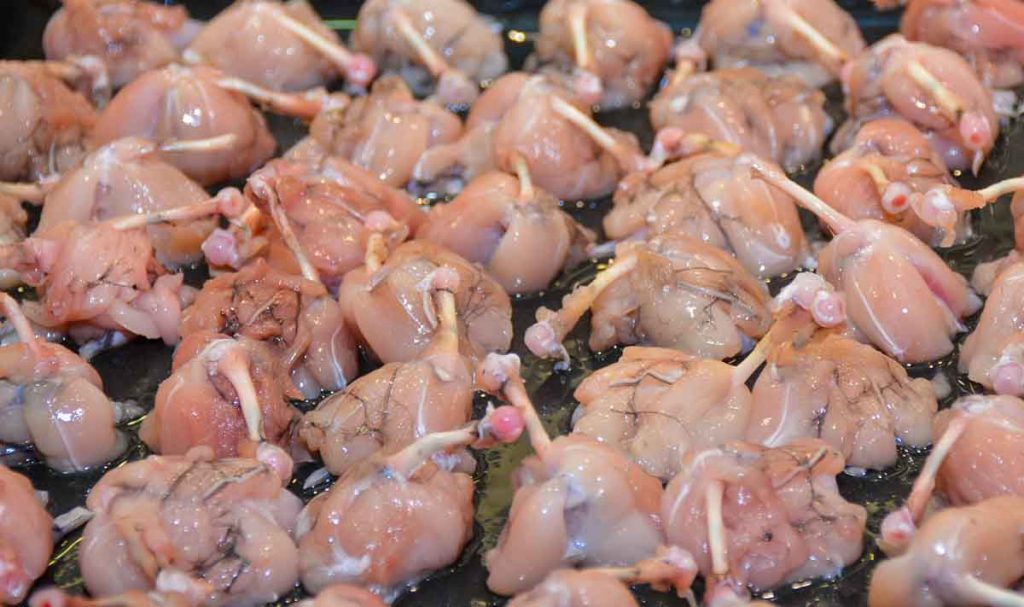
Although mythologized as the quintessential French dish. Frogs’ legs do not often appear on the typical French table. This delicacy is expensive and is usually found only in luxury restaurants. Traditional frog legs are served, like snails, with garlic, butter and parsley. The portions may also be combined with white or red wine, tomatoes, sometimes baked in herbal coating or Parmesan cheese. Frog leg meat is too delicate and has been compared to poultry. Despite the exclusive setting of a top French restaurant, it is customary to eat frogs legs with your hands.
Pate de Foie Gras
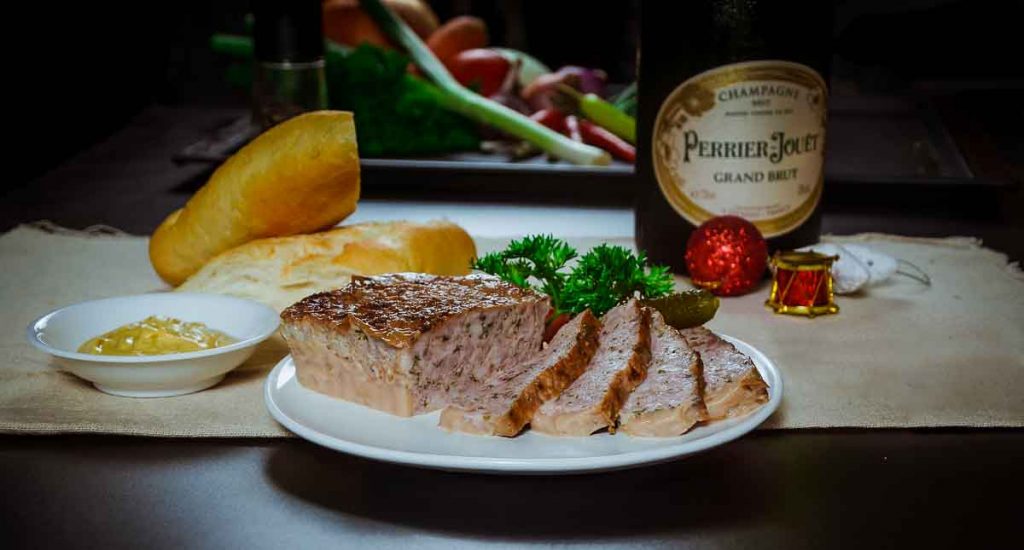
In France, a lot of attention is also paid to the light introductory course or “hors d’oeuvres” which translates as “outside the main work”. Foie gras is a world-famous goose liver pate, in the form of a mousse and served warm on small pieces of bread as the quintessential hors d’oeuvre.
Old school gourmets consider foie gras a delicacy, but this dish is controversial among animal advocates due to the cruel treatment of the birds from which it is produced. The geese were traditionally force-fed until they are so over fattened that their livers burst. 20,000 tons per annum of foie gras is now largely made from duck, but the force-feeding is no less intrusive and brutal.
Steak Tartare
Although sounding French and popular in France, Steak Tartare originated in New York and was originally introduced to France in the early twentieth century as steak “à Americaine” It is also popular across western and central Europe.
Steak Tartare is at the other end of the scale of meat quality from the cheap cuts which are braised with wine. The first significant point about tartare recipes is that they are eaten raw. These finest cuts of raw meat are minced, prepared and served fresh from the whole piece so that bacteria do not have time to get into the newly exposed surfaces of the mince.
In its international form, Steak Tartare is typically served with a raw egg yolk (another introduction from the New York prototype) and finely chopped raw onion, peppers and herbs. These are served alongside so that they may be added to taste by the diner. A more uniquely French version of the dish has it lightly seared around the edges of the reassembled patty.
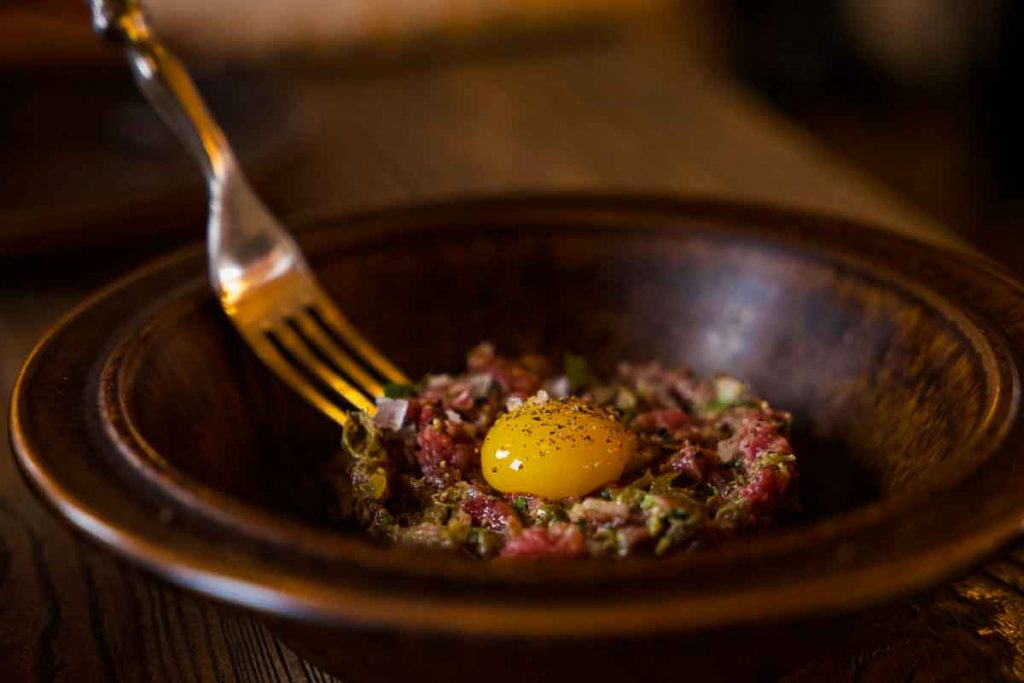
Salade Niçoise
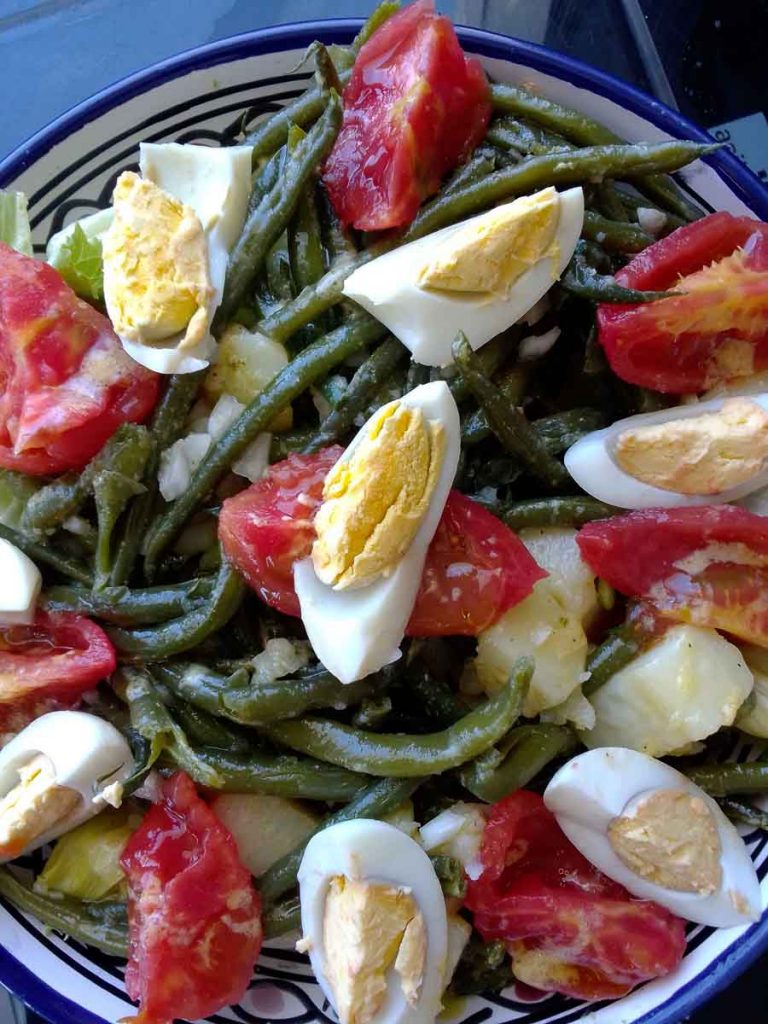
Originating in the French Mediterranean port of Nice, this salad at its simplest original is nothing but raw tomato anchovies and olive oil, to which are almost invariably added tuna, hard-boiled eggs and either raw salad leaves or cold cooked vegetables, often green beans.
Of course, there are endless debates about what ingredients should be allowed to be included in these recipes before the Salade Nicoise becomes something else. But whatever the rights and wrongs, there is something about the mixture of tomato, tuna, and hard-boiled egg with a dressing of oil that has found its way into almost everyone’s list of favourite salads. It’s good as a starter or as a light meal in itself.
Mussels and Moules Mariniere
Mussels (French: Moules) are another popular dish of French Cuisine. In France, moules are grown mainly on the coast of Brittany and in the French Basque Country. Traditional moules mariniere are cooked very simply in white wine with finely chopped onions and ground pepper. Of course, this is not the only way to make mussels. It is also served in Provencal sauce, curry, calvados, cheese or tomato sauce. How do you know the mussels are fresh? If you are cooking them yourself, they should be tightly closed before cooking, and then open when cooked, you should discard any which do not conform to this little choreography. If they are prepared for you in a restaurant, you can trust the chef.
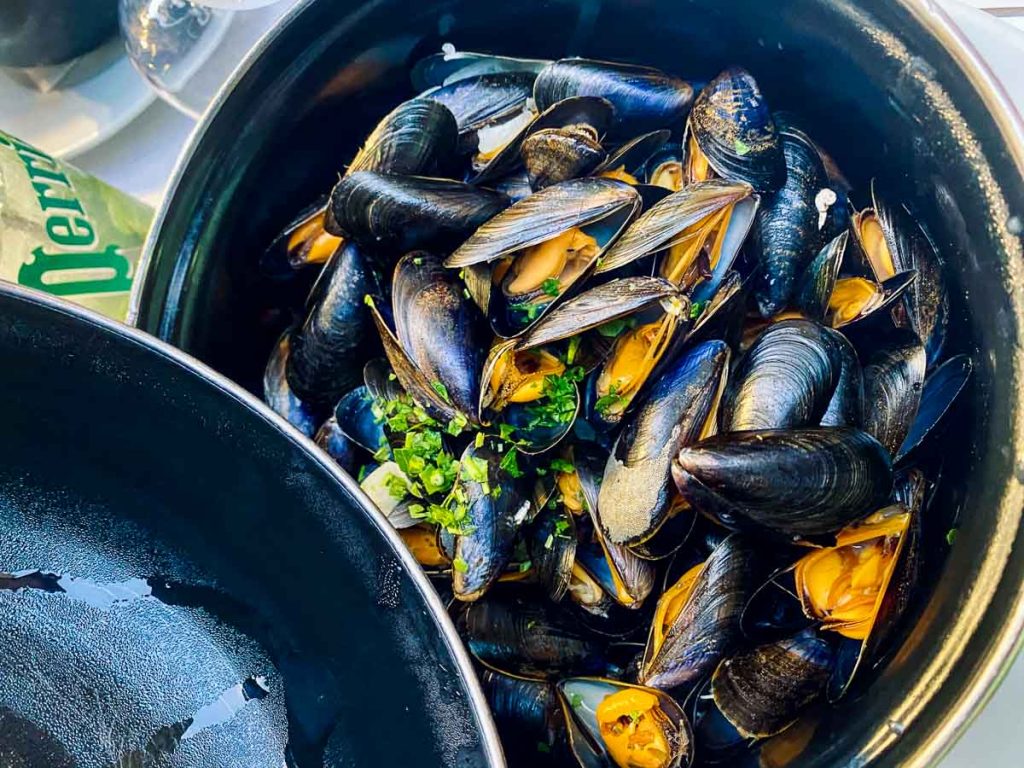
Mouclade Charentaise
Another Mussel dish is the famous Mouclade Charentaise. Charente is a small region on the Atlantic coast about halfway between Spain and Brittany. Famous for mussels, dairy products and pineau – a local wine fortified with cognac.
The Mouclade Charentaise combines everything sumptuous and tasty from the region in one delicious dish – Mussels, pineau, butter, cream, eggs, garlic.
French Cheeses
France is famous for its excellent quality cheese. Officially, there are over 400 different types of cheese. Each French region has its own specialities. The most famous French cheeses are perhaps camembert, brie and Roquefort (the last is a cheese with a blue mould made from sheep’s milk). French have as delicious goat cheese. They are served on platters with nuts, figs, grapes, baguettes and wine. Cheese is traditionally served in France at the end of the meal, perhaps because it contains conjugated linoleic acid which accelerates the metabolism, perhaps because the strong flavours would interfere with any other foods served after it.
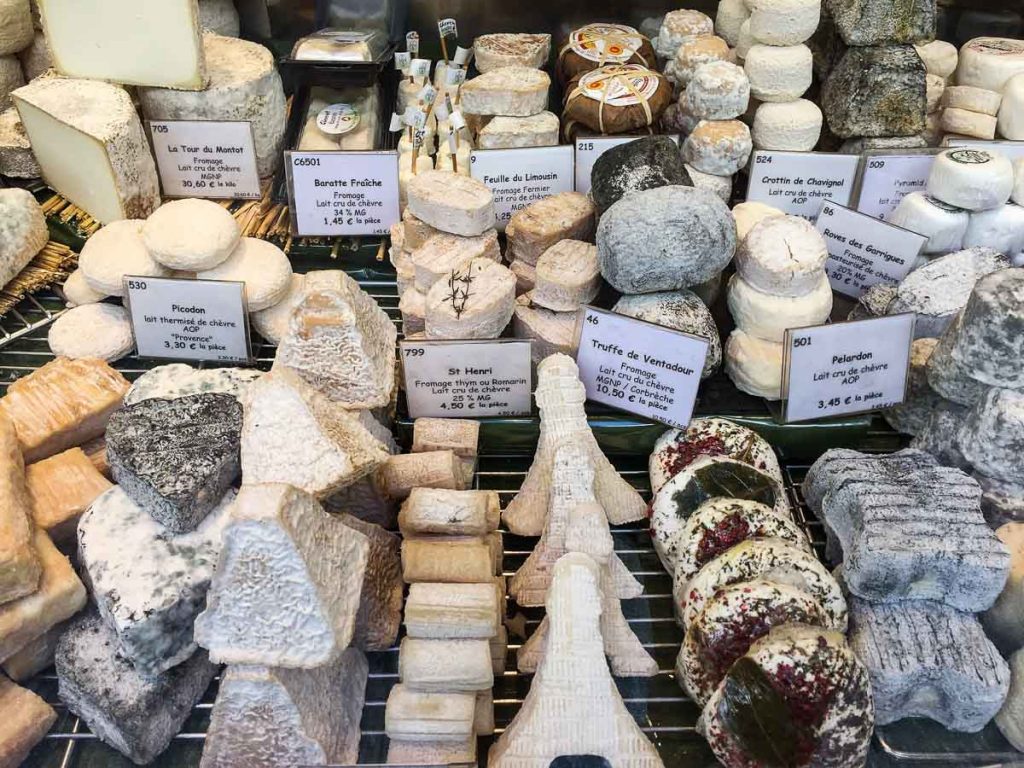
French fast food
Croque Monsieur, and Madame
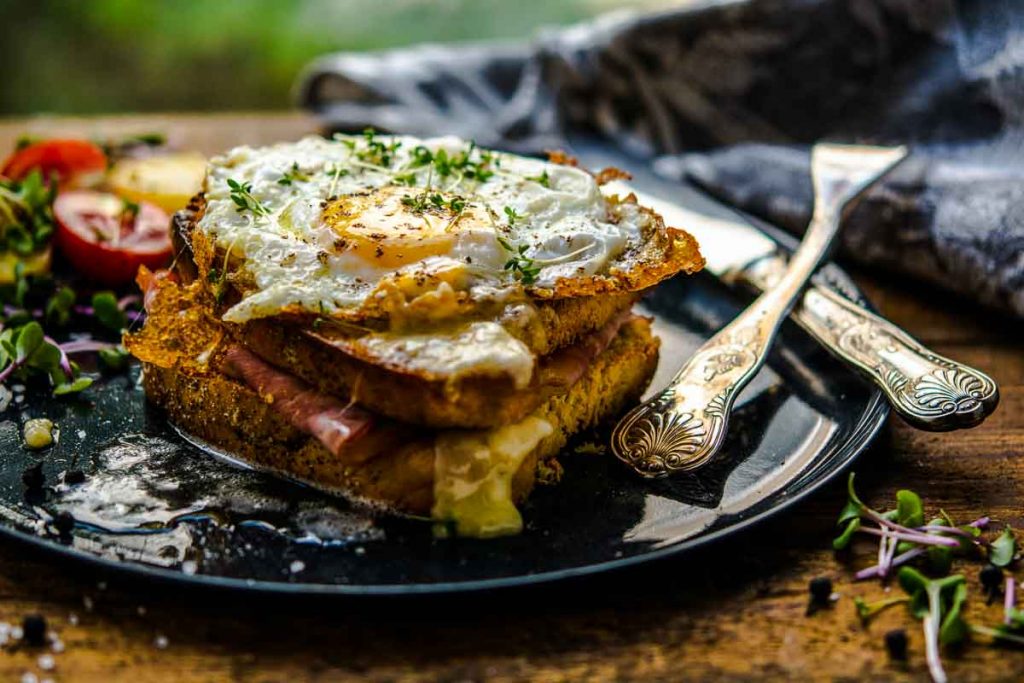
Croque monsieur – a loose translation might be “Crunch, Mister” – is a French pavement bar fast food. It is a toasted closed sandwich filled with melted cheese, ham and béchamel sauce. Croque monsieur can be pan-fried or baked in the oven. It is a filling and tasty snack that has made a name in restaurants around the world.
As with Crepes and Quiches, there are variant recipes, most commonly the Croque Madame. To prepare one of these simply put a sunny side up fried egg or a soft poached egg on top of your Croque Monsieur – et voila! Apparently, the running yolk might remind you of a lady’s hat – hence the name. But don’t ask me to wear one!
Quiche and Quiche Lorraine
Quiche Lorraine takes its name from the northeastern French province of the same name, but the recipe originally came even farther east, the word Quiche coming from the old German word for a cake or tart – Kuchen. The world-famous Quiche Lorraine recipes of today are salty shortbread open tarts (puff pastry crust) with a baked filling combining egg, cream, bacon and onion. Quiches including quiche Lorraine are available cold by the slice from viennoiseries everywhere in France for you to take home or enjoy as a picnic, but it is best fresh and slightly warm to maximize the flavour and texture. Quiche served like this can stand on its own even as the main course. Other quiches include those made with cheese, mushrooms, spinach or tomato, and named – au Fromage, -aux champignons, – florentine, and provençale respectively.
Quiche is considered a good accompaniment to Beaujolais Nouveau if you are in France in November.
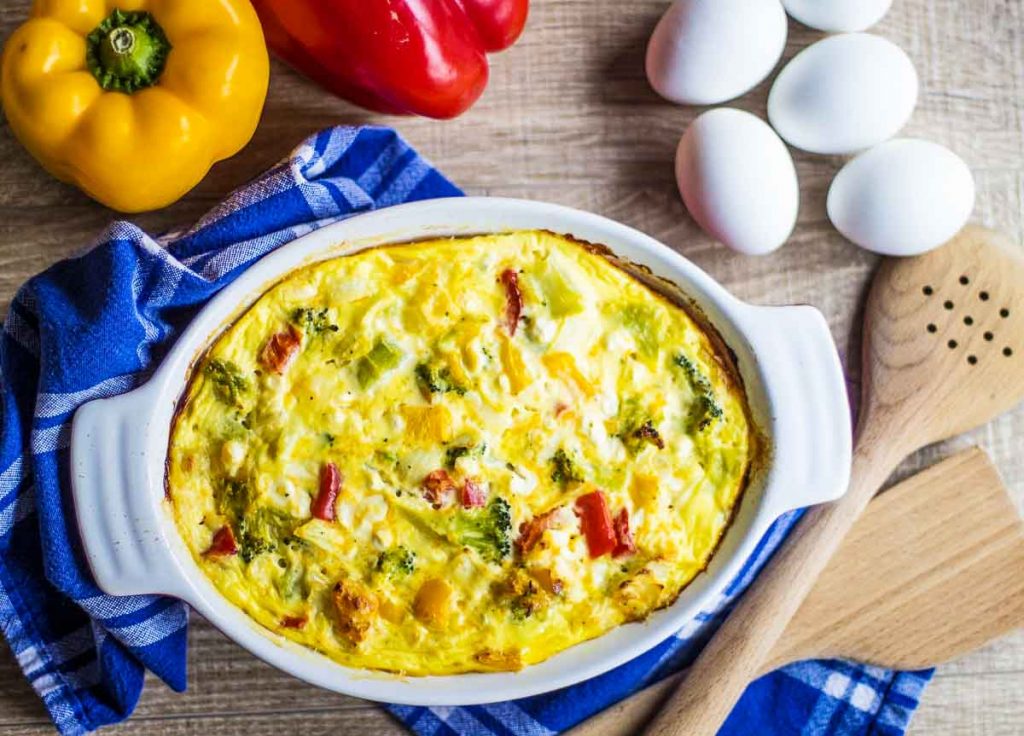
Crêpes and Crêpe Suzette


The famous crêpe is nothing more or less than a very thin pancake, served sweet with a variety of fillings: jam, fruit, whipped cream, even Nutella! The word “crêpe” in French means rolled up and, as you might imagine, French pancakes are served just like that.
The ultimate sauce for crêpe is the Suzette, invented by the renowned chef Auguste Escoffier at the end of the nineteenth century, perhaps for Edward Prince of Wales and named after his companion, or perhaps not – the stories vary. However, this lushest of crêpe recipes is distinguished by a sauce combining caramelized sugar and citrus zest, topped off with a flaming liqueur, either Curacao or Grand Marnier.
Crêpes are such adored foods that they even celebrate their own holiday. Forty days after Christmas on 2 February, pancakes are prepared to traditional recipes and eaten during the French crêpe festival of Chandeleur (Candlemas). Are French pancakes different from Polish ones? Typical crêpes are extremely thin with brittle lace-shaped edges. The taste is very similar, although some say the French version is a bit tastier.
French food – deserts
Macarons
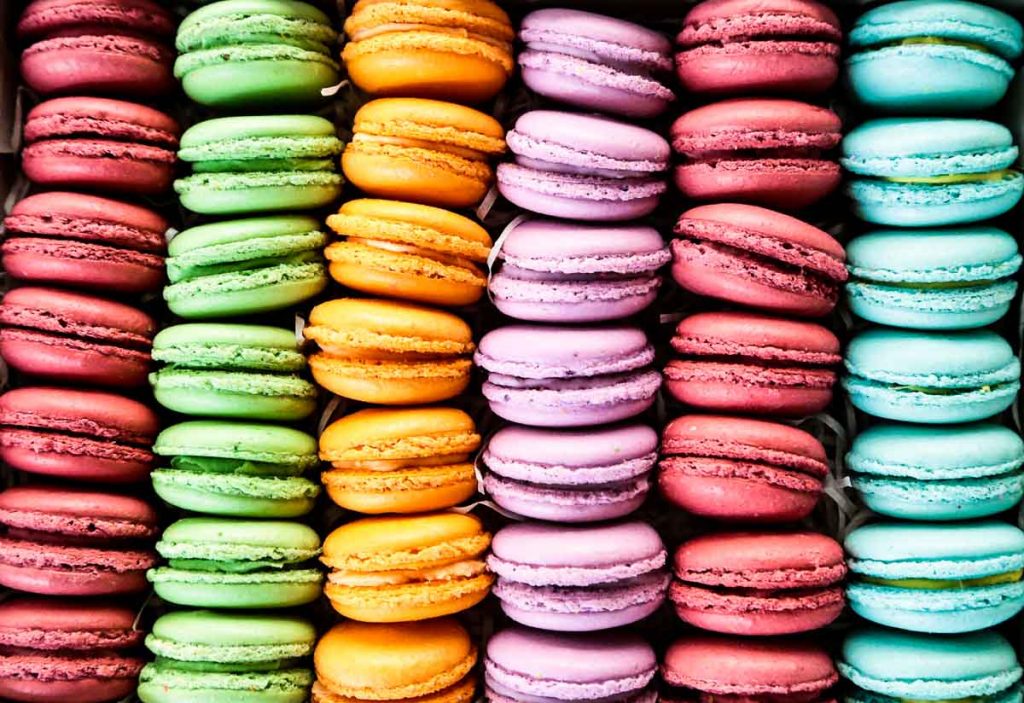
French Cuisine also means tasty desserts. Macarons have won over the palate of the whole world. These are small, two-layer meringue-like almond cookies, baked with whipped egg white, sugar and perhaps served with cream. While being popular in France, they were brought here from Italy by Catherine de Medici. Today’s macaroons are incredibly colourful, crunchy, and delicate, and above all – heavenly sweet.
Eclairs
The éclair doesn’t need to be introduced to anyone. These oblong cakes, made of steamed dough and filled with tasty cream, come from France. Their name means lightning. No wonder – they are so tasty that they disappear from the tables in no time. Eclairs come in many flavours, filled with whipped cream, meringue cream, and cream pudding. Covered with chocolate, eclairs are irresistible to all.
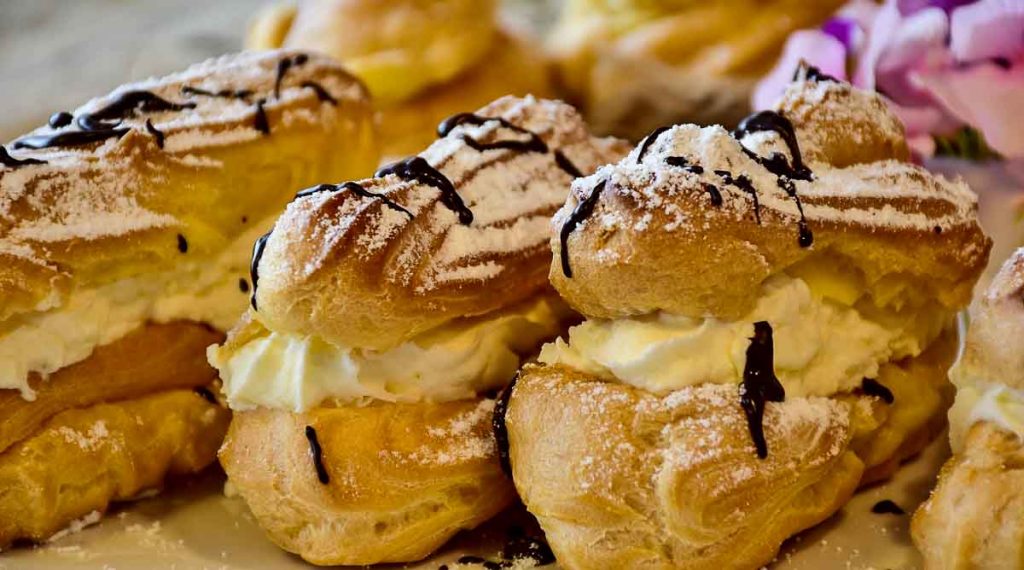
Soufflés
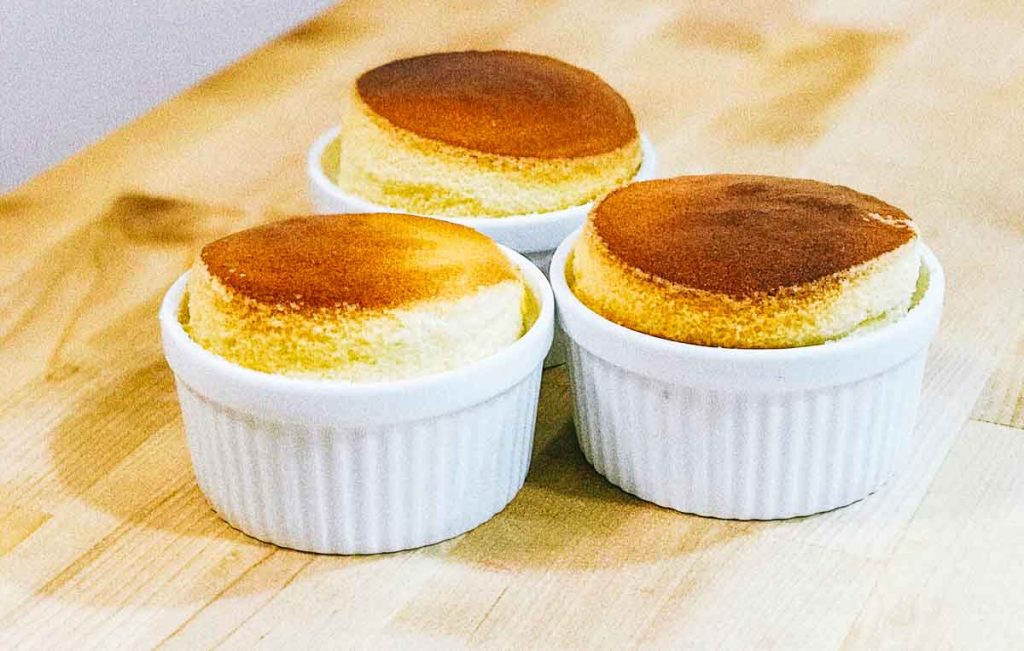
From the French word to puff up, the souffle is baked eggwhite, expanded by the heat of the oven, notorious for collapsing in the ovens of the inexperienced but always delicious when prepared for you by someone else. Souffles, like mousses, may be savoury or sweet. Typical savoury souffles include spinach, cheese and seafood eaten as an aperitif, whilst the sweet versions eaten for dessert will include some delicious creamy layer, often a sauce made with lemon or some liqueur in the mix, but other sweet souffles include recipes for fresh fruit, perhaps raspberries, and of course chocolate.
Flan – Crème caramel
Flan, also known as flan pâtissier or Flan Parisien, is a very popular cake in France. It is a kind of tart with a confectionery cream baked on a shortcrust pastry. The cream is prepared using heavy cream, milk, eggs, maizena or starch, vanilla
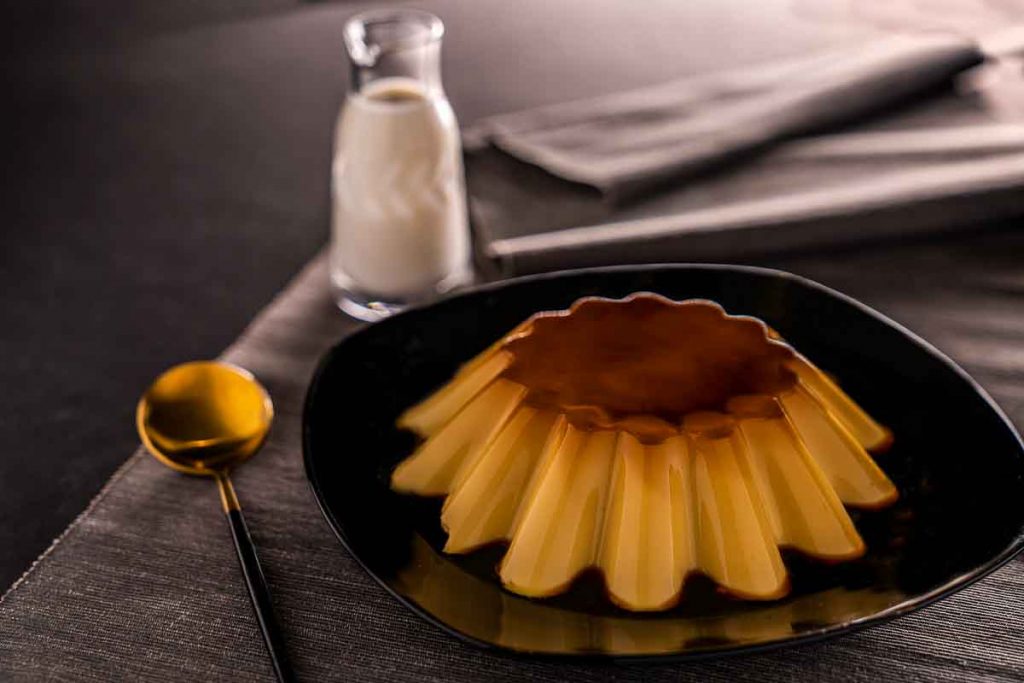
Tarte Tatin
The origin story for this apple dessert is quite recent. The two Tatin sisters ran a hotel in Lamotte Beuvron, south of Orleans, France in the 1880s, and one day the preparation of a traditional apple pie went wrong – the apple and sugar mixture was burnt, and the pie was then turned upside down to become a caramelized apple tart. It was served anyway and became popular. Despite its popularity, the sisters did not publish their recipes nor even name the dish.
The dish was only named after its creator’s death when it seems to have achieved a cult status amongst cookery writers and chefs. Or you can believe an alternative story that upside-down caramelized apple pies were already popular in the region for at least fifty years before it became the signature dish of the Hotel Tatin.
Whatever the truth of it, the Tarte Tatin itself is exceptionally tasty and has become an international favourite well beyond its place of conception.
picture of Tarte Tatin
Crème brulée
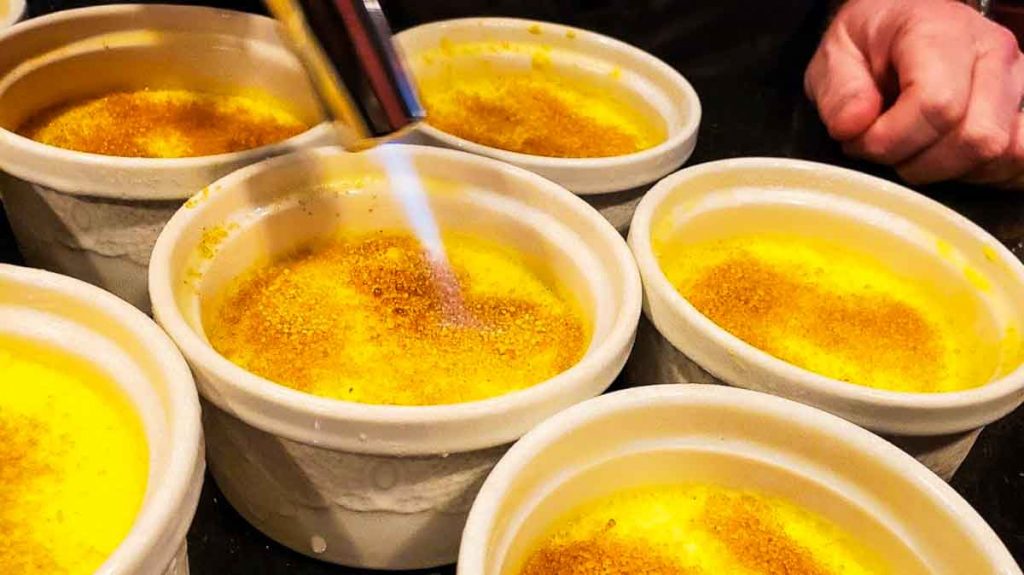
Créme brulée is one of the most popular French desserts. It is quite simple to prepare but has an exquisite taste. The basis of crème brûlée is cream, egg yolks and sugar under a crunchy caramelized surface crust. Various optional additions add character – most often it is a vanilla pod, but sometimes also chocolate or fruit. Served in ramekins, it tastes most delicious when the creamy body is very chilled and the caramelized sugar on top still warm. This is a real delight for everyone who loves sweetness, not only for greedy people!
In Languedoc Roussillon region they have Crème catalane which is their option of crème brûlée
Île Flottante, or Oeufs à la Neige
Whether you call this dessert a “floating island” or “snow eggs”, Ile Flottante ticks the box as unashamed nursery food: cold, pale, sweet, light, and sticky.
Its preparation is quite complex, has several variants and is notoriously un-foolproof. Some chefs add sugar to the eggwhite before whisking it, others swear that it must be blended afterwards, some poach the fluffy meringue islands others bake them. However the white islands are created, they are then served cold in a pool of delightful and fairly thin chilled custard – which the French call Creme Anglaise (English cream). The whole will doubtless be topped off with some sweetened red fruit – a strawberry compote or even poached cherries in rose syrup and perhaps some nuts to give a crunch.
Fondant au Chocolat
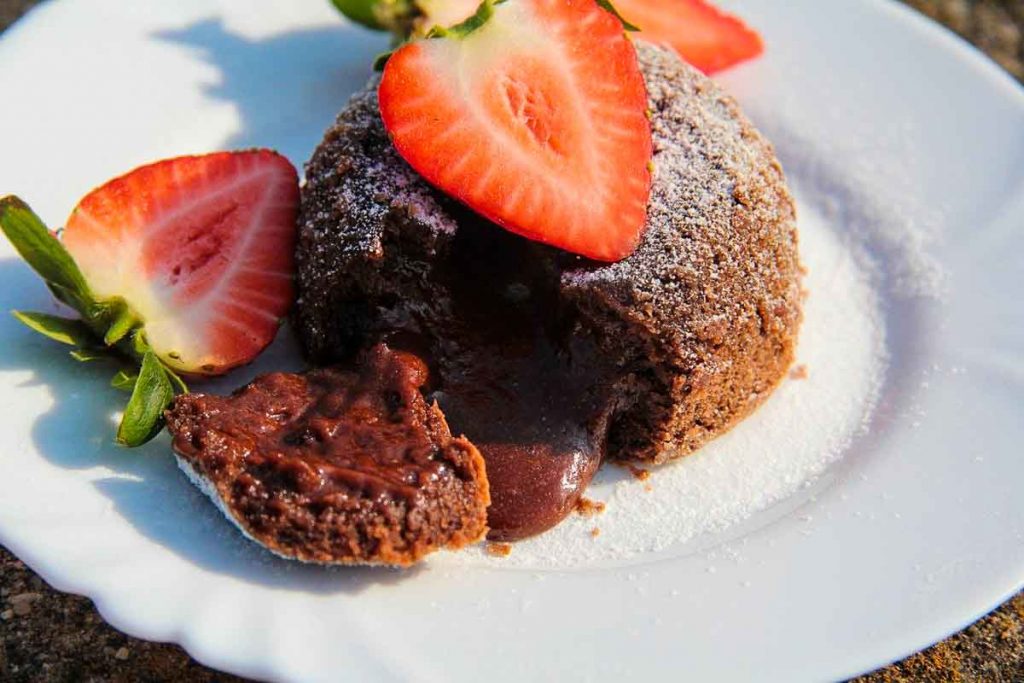
Well, what’s not to love about chocolate? and when it’s warm and soft (fondant) and served in France, then we will definitely be joining the queue for it. The term Fondant au Chocolat can cover a considerable variety of dishes, from molten chocolate lava cakes (The French and the Americans are still squabbling about who invented this one) to small hot chocolate sponge cakes, soft on the inside and traditionally served with ice cream. Making up the middle ground of this spectrum is a whole range of sponge cakes of different shapes sizes and even textures but sharing the common delight of warm fondant chocolate centres.
Mousse au Chocolat
Let’s stay a little with chocolate, and look at another way to optimize that most delicious ingredient. Instead of serving it gooey and with sweet bakery – the mousse is all about lightness. Mousse is simply the French word for foam – and is usually based on whipped egg whites.
Let’s stay a little with chocolate, and look at another way to optimize that most delicious ingredient. Instead of serving it gooey and with sweet bakery – the mousse is all about lightness. Mousse is simply the French word for foam – and is usually based on whipped egg whites.
Mousses may be sweet or savoury – the chocolate mousse is a light, airy celebration of eggwhite foamed chocolate and with very little else. Chocolate mousses are of course served worldwide; the French version is more chocolaty and less creamy than others, keeping the cream out of the mixture for serving on top or alongside. It is traditionally served in France in a glass, topped with fresh double cream and sprinkled with . . . more chocolate.
Flemish Carbonade
Here is a dish whose name seems destined to confuse – the name originally referred to meat grilled on coal fires, but it is nothing like that now, today the name carbonade is a stew of beef or sometimes pork, originating in Flanders in the borderlands between France and Belgium.
The distinguishing features of a Carbonade are the high proportion of onion in the sauce and the use of beer as opposed to wine. Traditional contributors to the characteristic carbonade flavour also include thyme, juniper berries, and mustard. Carbonade is traditionally eaten with bread rather than potato. It is a fine hearty meal to enjoy beside a roaring fire in winter. The carbonade has come a long way from grilled meat, but it remains delicious and a solid cheering feast.
Delicious French Food – Pin it



